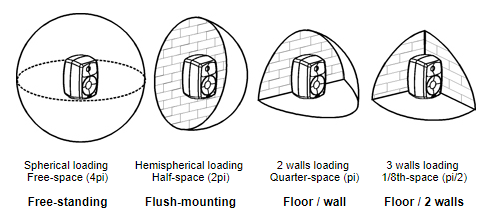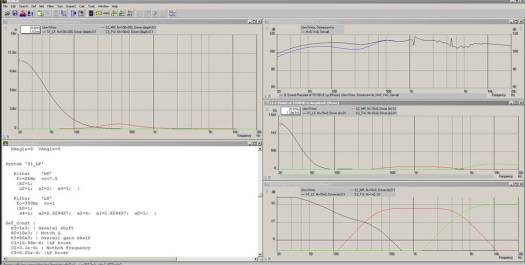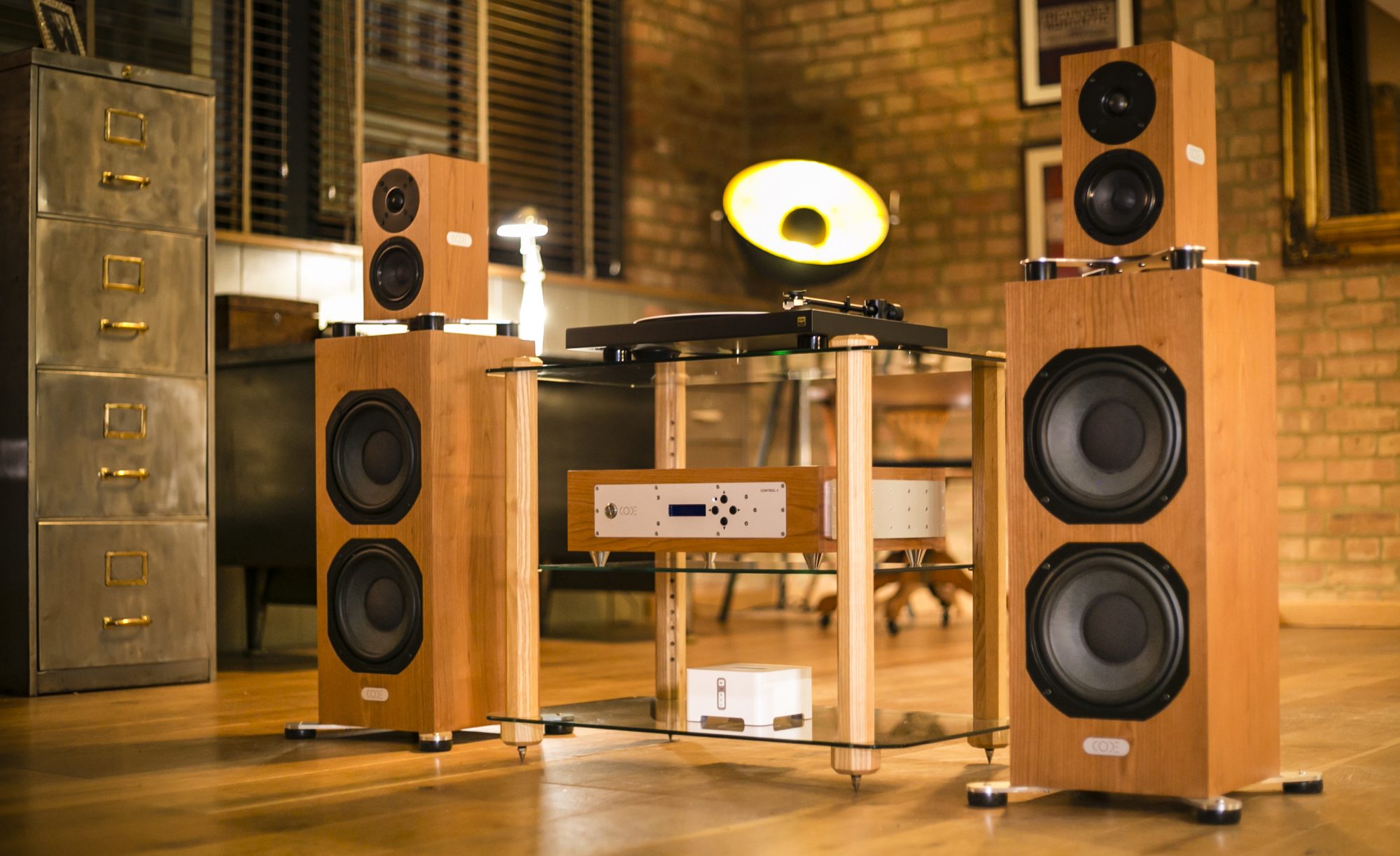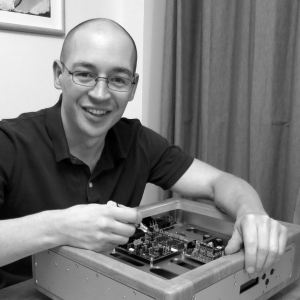Intro
Code Acoustics introduced our SYSTEM-2 concept at the National Audio Show in September 2016. We were awarded the ‘Best Innovation’ prize for our modular concept, nominated for ‘Best Presented Room’, and were judged to be the second best sounding room at the show by a panel of renowned Hifi journalists and experts within the industry. To say we were pleased would be an understatement!
The company had only been launched 3 months earlier, with a low-key debut at the North West Audio show in Chester, demoing our SYSTEM-1. It was only following this show that we made a last minute decision to design and build a brand new system, specifically for the National Audio Show.
Who’s the author?
My name’s Ceri Thomas and I’m the founder of Code Acoustics. In this article, I’ll take you through the journey of how and why SYSTEM-2 came to be.
What is SYSTEM-2
SYSTEM-2 is a high quality active 3-way speaker, one half of which you can see below. It consists of a stand-mount reproducing the mid and high frequencies, with four stand-alone bass modules each containing a 12″ drive unit (8 in total!). The electronics are held in an off-board control module.

The whole reason SYSTEM-2 came about was a bit of an accident. I booked the Chapel room at the National Audio Show back in February 2016 prior to SYSTEM-1 (below) being completed. The room measured a considerable 8.2 x 6.5m and to be completely honest It was a combination of naivety and brain fade that I selected such a large room.
My thinking was that some of the small show rooms can feel a little stuffy and claustrophobic, which I still stand by, but I hadn’t fully considered that such a large room would need a considerably sized sound system to drive it with authority.

It wasn’t until we demo-ed at the North West Audio show in a room measuring 4m x 5m that it dawned on me quite what a large room we had booked.
Shortly after, we concluded that whilst SYSTEM-1 was a very capable speaker, due to it’s compact dimensions, it’s sweet spot was small to medium, rather than large (or very large!) sized rooms.
So we needed something bigger, and again being slightly naive decided to design, build and tune a brand new sound system in less than 3 months!
SYSTEM-2 design brief
So as previously mentioned, SYSTEM-2 needed to be big, bold and look at home in a substantially sized room. Crucially it needed to sound excellent, but retain the ‘CODE’ DNA and build on what we had previously achieved with SYSTEM-1.
There was one additional caveat: I wanted to see if it was possible to produce a speaker that could not only play loud, but also go flat to 20Hz. Hifi speaker rarely achieve this and most (being ported) have a pretty sharp roll-off below their tuning frequency.
I had previously read comments from journalists and engineers that a well-developed low end has surprisingly beneficial consequences for the mid and high frequencies, which tallied with my own experiments and experiences.
In addition I personally like bass heavy electronic music (I can hear some of you groan!) and almost without fail this sounds better on big systems in a big room. Furthermore, CODE wasn’t set up to make ‘me too’ products and this was going to be anything but!
So perhaps this was just meant to be…
Configuration
SYSTEM-1 is a 3-way, sealed, DSP active speaker. We were very happy with this as a concept and our thinking is outlined in the article below:
CODE Acoustics – Why don’t you just make a passive bookshelf speaker, like everyone else?

However, to drive a large room with real conviction, you need to move a considerable amount of air. But to do this properly you need to move the air gently and that means a lot of diaphragm surface area. With this in mind the drive units would be a main focus of our energies in the initial design phase.
Electronics
The DSP and amplifier modules used in SYSTEM-1 had performed admirably, so these would be retained.
The digital signal processing (DSP) board was the Hypex DLCP shown below. This is a high quality, configurable, 6-channel DSP, capable of handling a source signal up to and including 24 bit, 192kHz.

The class-d amplifiers were Hypex UcD180HG HxR, producing 180 watts into 4 ohms @ 1%THD:

To give you an indication of quite how low the distortion is from these units, please see the graph below. Even at 40 watts the amplifier is at less than 0.02% THD!

These would be powered by the almost industrial in scale SMPS1200A180 switch mode power supply:

The electronics were to be mounted in our CONTROL-1 box and again this could be carried over from SYSTEM-1, though it was anticipated we would need an additional box to power the increased number of drive units:

Drive units
We made an early decision that we would carry-over the tweeter and mid range units from SYSTEM-1.
The tweeter is a lovely little unit from Scan-Speak; namely the D2905-95000 (below). This design has been around a while and is part of the ‘classic’ range.
Click to access d2905-950000.pdf

Sometimes manufacturers just get a particular product right and this is one of those examples. It’s got a fantastic flat response that requires very little EQ and a nice gentle roll off above 20kHz, without that nasty resonant spike you can get with metal domes (even the en-vogue Beryllium ones):

We intended to cross the unit over at 3.5kHz with a 4th order L-R filter and combined with it’s very high 150 watts power handling meant achieving a high SPL wouldn’t be an issue.
The midrange drive unit is the 12MU/8731T00 (below) from Scan-Speak’s Illuminator range. This is one of the finest midrange drivers in the world and I recently spotted it on a speaker costing well over £100,000!
We were perhaps unsurprisingly really impressed with this unit from our SYSTEM-1 development. It’s a very well behaved driver, with flat frequency response and relatively high power handling of 80 watts. With midrange units it’s often power handling that’s the limitation rather than x-max and there is usually a particularly high demand around 1kHz.

With this in mind we decided to choose two of the 8 ohm mid drivers (as used in SYSTEM-1) run in parallel to give a 4 ohm load. Using the two unit would now give us a mighty 160 watts power handling, which is pretty important when you’re searching for fairly high SPL.
The Scan-Speak’s frequency response can be seen below:

Using two drivers also means the units work half as hard; voice coil temperatures are kept lower and the diaphragms are making far smaller movements. These are all good ingredients for a laid back, low distortion sound. The only thing to watch is that the two units will interact at certain frequencies, adjusting the polar response slightly.
If you’re not sure what a polar response graph looks like, here is an example for a B&C 6FHX51 drive unit. It essentially shows how the distribution of sound changes as frequency varies. Simply note here that as the frequencies rise, the sound from the drive unit is becoming increasingly directional.

So the next bit is the interesting one; can we find a bass driver that would marry up to the midrange units, run flat to 20Hz, but not limit the max SPL of the system? Power handling and x-max would both really be tested here!
We made an early call that we wouldn’t use the Volt BM220.1 (below) bass driver from our SYSTEM-1. It’s a lovely unit with a tight punchy bass, but it’s x-max of 5.5mm, limited radiating area and fairly high fs of 35Hz would mean we would need a great many of them for SYSTEM-2. In general (space permitting) I prefer the sound of larger diameter bass drivers; to me they just sound more natural and we didn’t have the package constraint of SYSTEM-1. So we were on the lookout for a new bass driver, and this is where we needed to start running some simulations.

I was initially keen to follow a similar path to the BM220.1 i.e. a PA bass driver with big magnet and light cone that would give a similar sound. But the big question was could we run low enough? We decided to look at 12″ and 15″ units. An 18″ unit would have been really interesting, but mating it to a 4″ mid could prove difficult.
A bespoke Akabak script was used to simulate drive unit behaviour within the system. The initial assumption was two 8 Ohm drivers, running in parallel and sharing a 50 litre box. The target bass extension was -6dB @ 30 Hz in free space, which would likely take us flat to 20Hz in a ‘normal’ room.
The diagram below shows the various types of loading a speaker may encounter:

A ‘real world’ domestic speaker would likely experience 1/4 space if not 1/8 space. With a fairly low ceiling you’re moving beyond 1/8 space towards 1/16th space. This has the result of amplifying the speaker, providing additional gain that is most notable by extending the bass response.
The initial results were not promising. All the PA drivers we simulated either ran out of excursion or in most cases ran out of power handling. The best unit we simulated was the Beyma 15SW1300Nd-8 (spec page and simulation shown below*):
* Note only one drive unit is simulated i.e. one tweeter, one mid and one woofer
https://www.beyma.com/products/lowmidfrequency/115SW13ND8

*Apologies for the fact the images are a little small, but you can zoom in!
Bottom right shows the crossover slopes between the three drive units (green = tweeter, red = midrange & back = woofer). These are 4th order Linkwitz-Riley (L-R) filters at 3.5kHz and 250Hz. Note there is EQ (gain) applied to the bass drivers to achieve our aim of -6dB at 30Hz.
Middle right shows the power handing of each driver. Note that the power capacity of the tweeter and woofer are a fraction of the Beyma’s mighty 1300 watts!
Top right shows the rough system frequency response. The crossovers aren’t optimised so this really just gives a general feel of how the system will perform at the frequency extremes.
Top left shows the drive unit excursion where you can see (with very keen eyesight!) the tweeter has 0.4mm x-max, the midrange driver 3mm x-max and the woofer 10mm x-max.
On paper this looked really good, with our bass target of 30Hz @ -6dB being achieved before we ran out of power handling or x-max. Unfortunately to reach the target each bass driver would require 1.2kW each, or 2.4kW in total per side! We could reduce power requirements by increasing the volume of the speaker, but I was keen to keep the speaker fairly compact.
Hypex do make a module capable of outputting 2kW into 4 Ohm at 1%THD (their UcD2K):

The Hypex modules are extremely efficient at circa 90% when being pushed hard. However, with a 2kW amplifier, that’s still 200 watts (a lot!) of heat that needs dissipating, as well as the heat from the associated power supply. This was viewed as being challenging, though not unachievable.
There was however another variable, which killed this concept; the drive units were custom order, direct from Beyma with a long lead time that wouldn’t work with the fact the show was fast approaching.
So we decided to knock the PA driver idea on the head and look at a couple of more conventional Hifi subwoofers. Though we couldn’t use any old Hifi subwoofer. It was important the diaphragm wasn’t too heavy (as they often are), due to the fact we wanted good upper bass performance, as well as a good integration with the midrange units.
The unit that caught our eye was the 12″ Peerless 835017:

Click to access XXLS-P835017.pdf
This driver had an impressive x-max of 12.5mm, low Fs of 22Hz, relatively high efficiency of 88dB @2.83V/1m, a pretty flat frequency response and it looked like it would worked in small enclosure volumes:

But perhaps the best feature is the fact it uses an aluminium voice-coil, on an aluminium former with an aluminium diaphragm. What this means is the whole diaphragm effectively acts as a massive heat-sink removing heat from the voice coil and allowing it to run at high volume for extended periods without running into power compression*.
*This is where the voice coil starts to heat up to the point where it’s behaviour starts to change and is just one of the many forms of distortion that can affect a sound system.
So we ran the simulation as before with 2 units in a 50 litre enclosure:

Unfortunately as with the PA drivers, we were exceeding the power handling. However, we could see the driver was well suited to a small enclosures by the limited amount of EQ required to bring the bottom end up. So we re-ran the simulation, but this time with 4 units is a 70 litre enclosure:

Finally we had a solution! We were almost bang on the power handling limit of the bass driver (as with the tweeter and mids (bottom left)), but the real positive is we were now down to a relatively modest 6.5mm cone displacement (on the woofer) to achieve it. Also note the ‘in room’ blue trace mid right, which shows we are pretty much flat to 20Hz!
We now had a really well balanced system. All the drive units were running out of power handling at the same point whilst achieving a very decent max SPL, being 108dB in free space. The radiating area of the Peerless subwoofer is 483 cm squared giving 3,900 cm squared for the combined 8 drive units, which is just shy of being equivalent to four 18″ drive units!
This solution also worked well from a DSP / amp point of view. The tweeter, midrange pair and every bass driver could have their own UcD180HG amplifier by daisy chaining two DSP modules. So effectively, we just needed two CONTROL-1 boxes to run the system!

Wrap Up
That’s all we’ve got time for in part one, but in part two we’ll look at cabinet design, manufacture, voiceing, room set-up and press / customer reaction to SYSTEM-2 at the show.
In part three we’ll take a look at the modified SYSTEM-2 production design.
Thanks for reading and please let me know your thoughts.
Ceri Thomas
Founder
Code Acoustics




One Reply to “”